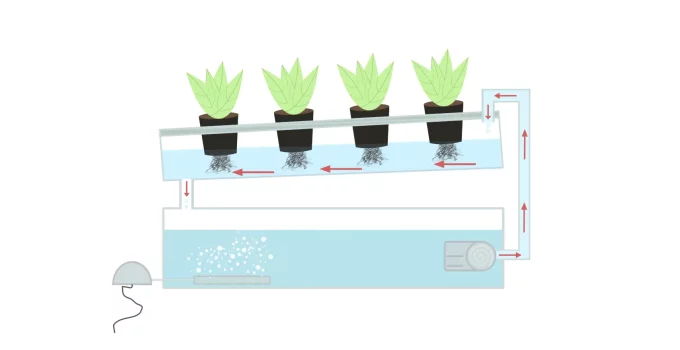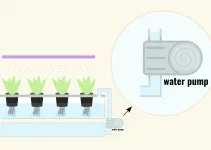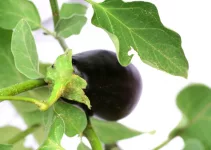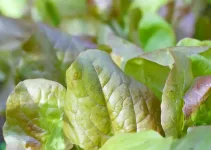There are 6 main hydroponic systems: wick system, deep water culture (DWC), ebb and flow (flood and drain), nutrient film technique (NFT), drip system, and aeroponics.
I wish I could say that the nutrient film technique hydroponic system is the one most frequently used by commercial growers. However, according to this article from Oklahoma State University, the drip system is probably the most widely used type of hydroponic system in the world. I agree because drip systems are very efficient and can help us grow any plants we want.
Besides these 6 hydroponic systems, we can also grow using the Kratky method. One very popular option is the Kratky method with mason jars as containers.
Plus, we also have the option to grow both plants and fish in the same system, which means that we’re building aquaponics systems.
That’s the world of hydroponics and the main ways we can grow plants at home. And maybe sometimes fish for those who enjoy both.
However, this article will only focus on answering what the nutrient film technique hydroponic system is, which are the benefits of the nutrient film technique system, how you can build one at home or maybe you’d be interested in buying a kit that you just have to assemble at home, and we’ll also talk about plants that can be grown in a NFT.
Table of Contents
What Is the Nutrient Film Technique Hydroponic System?
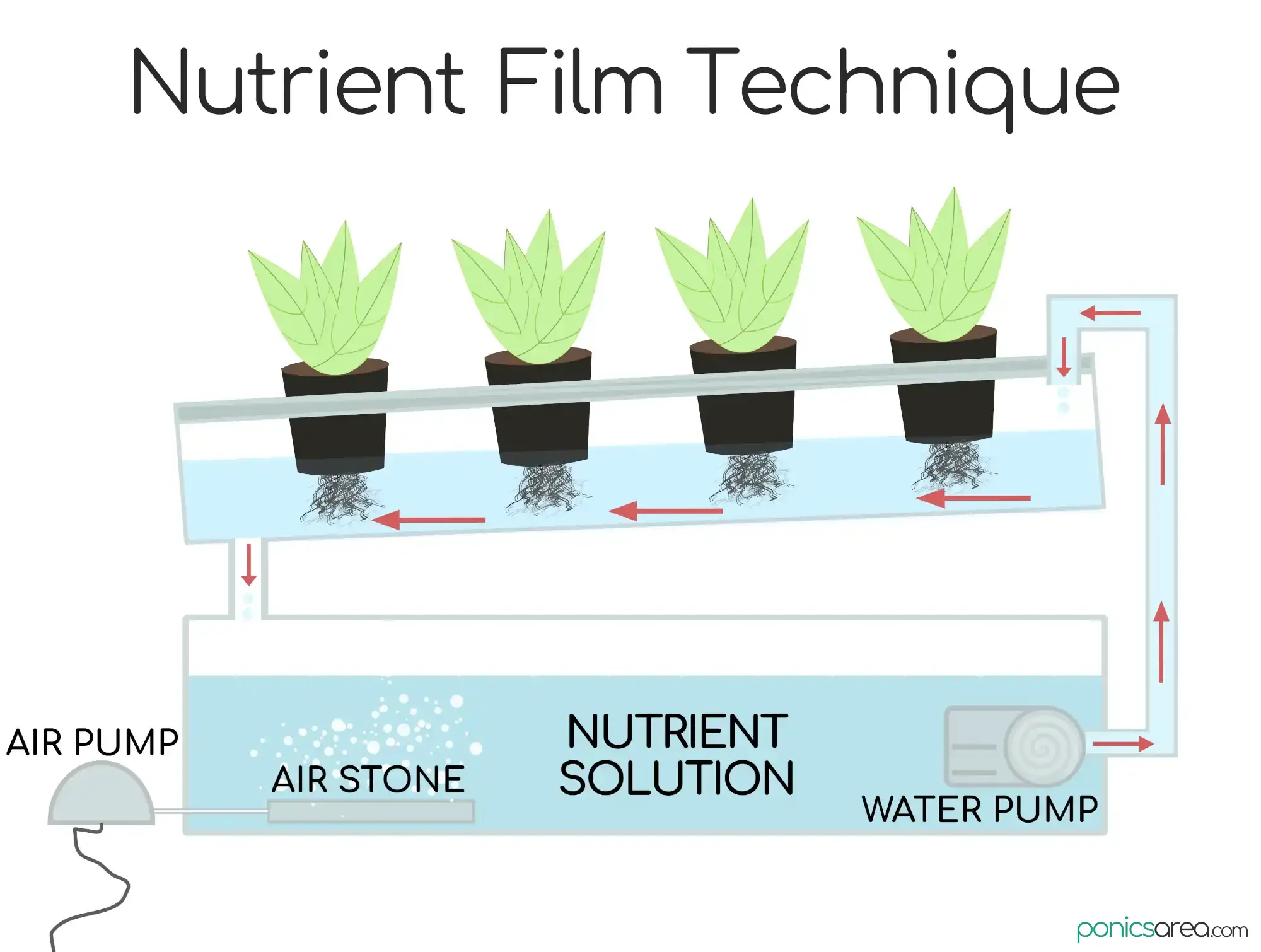
A nutrient film technique system is usually made with PVC pipes where the net pots in which plants are grown are inserted at a certain distance.
The channels are inundated with water and nutrients pumped up by a hydroponic water pump.
The PVC pipes are set on a slight incline, an inch every several feet or so, so that the excess water and nutrient solution is returned to the reservoir to be reused.
It’s a system that works continuously because there’s no timer.
Nowadays, the NFT abbreviation makes people think of entirely different things, digital things that only exist on computers or phones.
For us, people passionate about hydroponics, NFT stands for something completely tangible, it stands for a system that is made of many components and we just have to discover everything about them.
Some people have the habit of saying that a NFT is an ebb and flow without a timer. Sure, let’s make this comparison assuming that it explains much.
I guess we could say that the two are similar in some ways but they also differ because the grow beds/PVC pipes for an NFT must be set up on a slight incline in order to return the water with nutrient solution to the reservoir to be reused. It’s a closed system.
Also, ebb and flows use mainly big grow beds or grow trays, while NFTs are made with PVC pipes as channels to grow the plants in. We can also build an ebb and flow with PVC pipes or build a NFT with grow beds/trays but that’s not the classic configuration for either.
I think that we need more info to understand what a NFT system is without comparing it with another one.
NFT components
To better understand what exactly a nutrient film technique system is we need to talk about its components.
PVC pipes
A classic NFT is composed of a PVC pipe or several PVC pipes either stacked one on top of the other (helix shape) or set up in a parallel formation in rows.
The PVC pipes are drilled so that we can insert the net pots. We can either use a growing medium or we can skip on using a growing medium entirely. That’s up to us and it also depends on what plants we are growing.
Of course, we can also use grow trays or grow beds to grow crops in a NFT system. We don’t necessarily have to use PVC pipes but these channels are the most popular choice when it comes to building a nutrient film technique system.
So, we have our drilled PVC pipes where we insert the net pots.
We can use a growing medium or we can skip it.
What else do we need?
We also need a reservoir for our water and nutrient solution. That’s a common component for all hydroponic systems.
There needs to be a hydroponic water pump that is powerful enough to pump up water and nutrient solution through all our channels. If we’re stacking up our PVC pipes, we need to consider how high the water pump has to pump up the water with nutrients.
Of course, we need an air pump and an air stone. Using these two allows us to properly oxygenate the nutrient reservoir, which goes to the roots of our plants. It can also prevent algae and disease growth in the reservoir.
Last but not least, we need an over flow pipe/hose to return the excess water with nutrients to the reservoir to be pumped up through the channels again. That’s why it’s a closed system.
As you can, there’s no timer. The three hydroponic systems that employ a timer are ebb & flow, drip, and aeroponics. The three that don’t are: wicks, DWC, and NFT.
How to Build a Nutrient Film Technique System
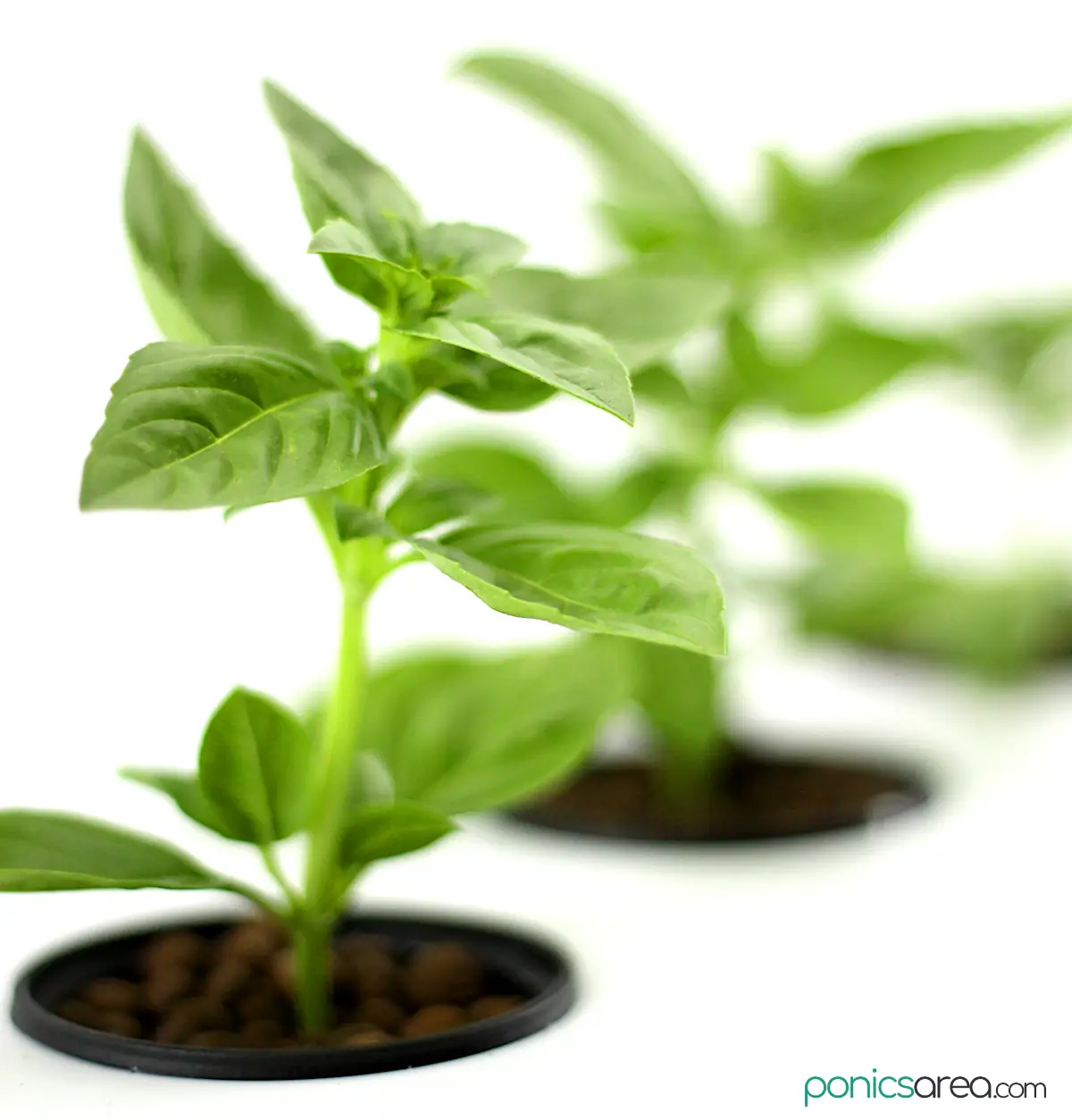
Frankly, the best way to go about learning how to build a nutrient film technique hydroponic system is by watching a lot of tutorials online. You need visual guides if you want to build a successful model.
There are tons of tutorials on YouTube, you just need the time to watch them.
Personally, I think it might be easier to build a drip system than it is to build a NFT. I consider it to be one of the most technical systems, if we forget about aeroponics.
Let’s recap the components we need for setting up an NFT:
- reservoir
- PVC pipes – round or square
- net pots
- growing medium (optional in some cases, like for growing lettuce and smaller plants)
- hydroponic water pump
- air pump, air stone connected
- over flow pipe/hose
The main principles of a nutrient film technique system are:
Right channel slope. Right flow rate. And right channel length.
Decide which net pots you’re going to use before drilling their holes for their size. For growing lettuce and other small plants we can use 2-inch or 3-inch net pots. I prefer the 3-inch ones.
The PVC pipes need to be set up on a slight incline so that gravity returns the water that flows through the channels and through the roots to the reservoir.
You need to arrange the pipes in a helix shape (PVC pipes one on top of the other) if you have limited space. And if you are comfortable sticking to growing only smaller plants (lettuce, leafy greens, herbs, strawberries). Or we can set up the pipes in a system that spirals around itself.
The water pump must be powerful enough to pump up water and nutrients up through the pipe that sits on top.
However, the water is pumped up at a slow enough pace that only a thin line of water and nutrients is left on the bottom of the channels for the roots. The thin line of water and nutrients also allows the roots to get all of the air they need. We must not flood the channels.
Designing a nutrient film technique system for larger plants
Before reading what I have to say, check out this video to see how a NFT for larger plants is set up.
You’re going to see that the pipes are set up in rows in a parallel formation, they’re not stacked up one on top of the other (helix shape) because larger plants don’t only grow large roots, they also grow very tall.
Thus, a nutrient film technique system that is used for growing plants like tomatoes, cucumbers and peppers is going to require a lot of space. It also depends on the number of plants you plan on growing at one time.
The PVC pipes need to be 3 or 4 inches in diameter.
You’ll also need 6 inch net pots so you’ll have to drill the holes to fit 6-inch net pots. We also use 6-inch net pots to grow larger plants in 5-gallon buckets DWC.
Also, remember to set up your pipes on a slight incline so that the excess water and nutrients can be returned to the reservoir due to gravity.
For larger plants, you’re also going to need a growing medium. You can use hydroton (clay pebbles).
Which plants can be grown in a NFT system?
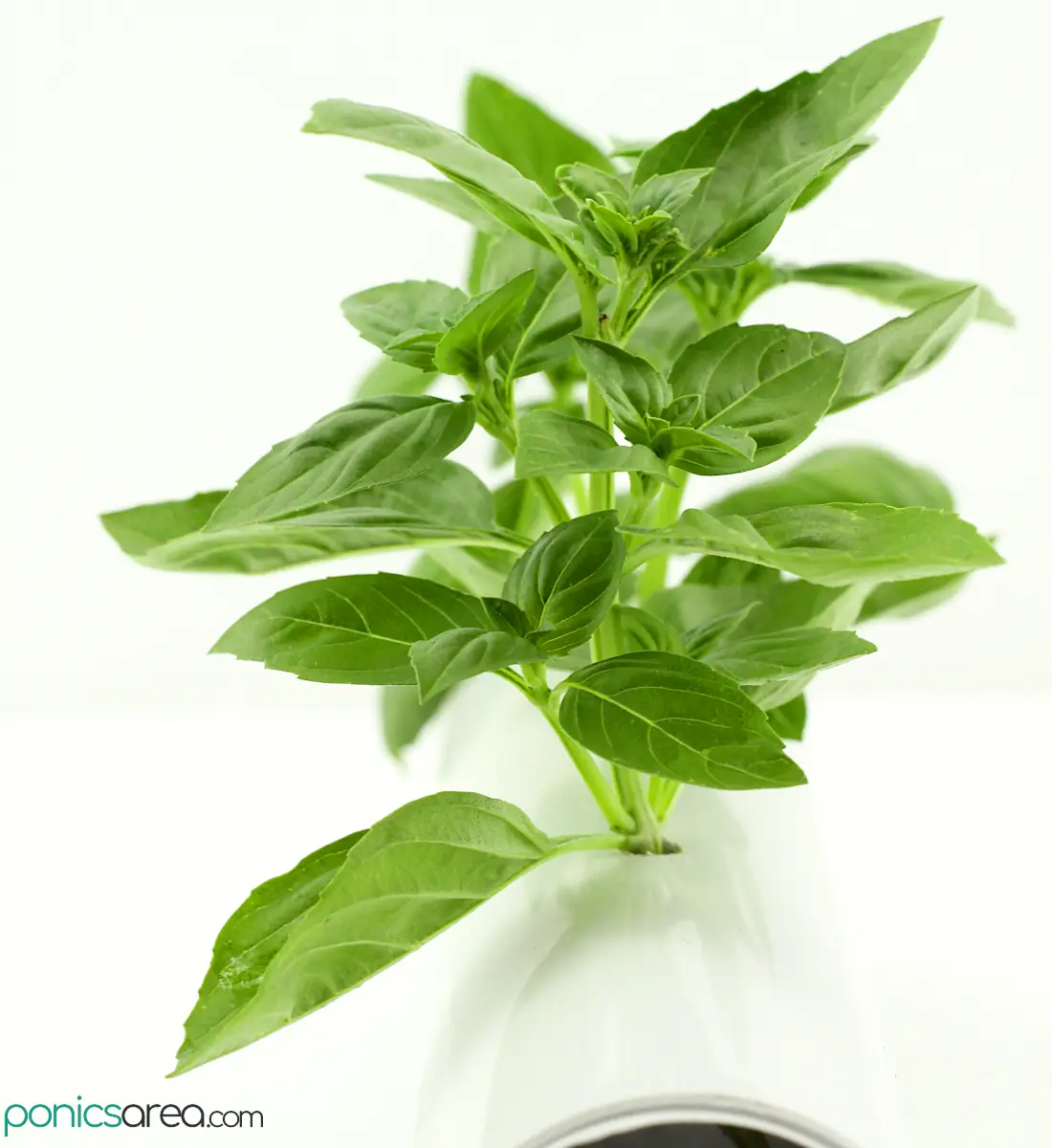
In theory, we could say that we can grow any plants we want.
In reality, we should mention that nutrient film technique systems are primarily used to grow smaller plants and they grow really quickly so that’s certainly an advantage.
Another advantage is that the utilization rate of water and nutrients is high.
Since we can also stack up PVC pipes one on top of the other, we economize space so this type of NFT is great for growing a large number of small plants without taking up much space at all.
Nutrient film technique systems can certainly be used for large-scale production of smaller plants.
The main plants that are grown in NFT hydroponic systems are:
- lettuce
- leafy greens and baby greens
- herbs
- strawberries
Could we expand or design a NFT to grow bigger plants like tomatoes, peppers, cucumbers, etc.? Of course we can. It’s not impossible, it’s just assumed that nutrient film technique systems are used for growing smaller plants that don’t need really big net pots for developing their roots.
After all, we can grow cherry tomatoes or peppers or cucumbers in indoor hydroponic gardens like the ones from AeroGarden or we can grow them using the Kratky method. If it’s possible for those, it’s certainly possible for nutrient film technique systems used by amateur growers.
According to this article, tomatoes can be grown in nutrient film technique channels. The thing we must keep in mind is that the larger root systems necessitate larger channels and can impede achieving the target flow rate of nutrient solution. The writer of that article advises against NFT systems being used for commercial production.
But they can definitely be used for household production if your PVC pipes and the net pots inserted in them are big enough to allow the roots of larger plants to develop and to also ensure that the roots don’t block the passing of water with nutrient solution so that it can reach all plants. That’s the complicated thing to achieve.
Thus, if you’re just starting out with nutrient film technique hydroponic systems, stick to smaller plants in the beginning.
All in all, ebb & flow and drip systems remain the two best hydroponic systems for larger plants (tomatoes, peppers, cucumbers, etc.).
Nutrient Film Technique Disadvantages
There’s no perfect hydroponic system that is 100% fail proof. They all have their advantages and disadvantages.
Water pump stops working
In a nutrient film technique hydroponic system water with nutrients is pumped up through the channels constantly and the excess is returned to the reservoir quickly. It’s a system that never stops.
If we have a timer, a system is only active when we time it to be. Both types have their advantages and disadvantages.
For example, the roots will dry out and the plants will die if the water pump in a NFT stops working for any reason, including power failure. It’s quite a serious thing to take into account but the same can be said for any system that uses a water pump: drip, ebb & flow, and aeroponics.
The only ones that are not in danger from power failure or a water pump that doesn’t work anymore are wicks, DWC, and the systems that are built with the Kratky method.
Taking the nutrient solution up through the top
Choosing the right pumping is crucial for the successful running of a nutrient film technique system.
If we arrange our NFT system in a helix shape, we need to make sure that our pump is good enough to allow the flow of water and nutrients up through the top.
If we arrange the PVC pipes in a parallel formation in rows, then we need to make sure that the water pump can pump up water and nutrients until it reaches the other ends of the pipes.
This is among the hardest parts about a nutrient film technique system.
Depending on the size and construction of your system, you might need several reservoirs, each with its own pump.
Is the NFT hydroponic system good for beginners?
It has a small chance of being easy to build for a few beginners. Like, if you are used to building things at home and you know your way around drilling holes in PVC pipes and how you can stack them one on top of the other to grow plants in net pots. If you have a lot of space, you can just place the pipes in rows but that takes up a lot of space.
You will need to do research about water pumps, water and nutrient solution, flow rates, and everything else.
Generally, I wouldn’t say that beginners should start their journey by building a nutrient film technique system as their first ever hydroponic system.
People usually recommend starting with a simple DWC, either built from a storage tote with lid or by linking 5-gallon buckets for a slightly more complicated option.
If you are even less technically inclined or you don’t have a lot of time or space or you have a limited budget, then you might actually prefer the Kratky method.
Or you can buy one of those indoor hydroponic gardens, like the ones from AeroGarden or iDoo, if you want some of the smallest hydroponic systems.
Should you buy nutrient film technique kits?
The alternative to building your own nutrient film technique system is to buy a kit that you just have to put together and then buy a few other things to make it perfect. Most of the components we need should be included by nutrient film technique kits.
However, we still have to see if these kits are any good and what previous buyers think of them.
Let’s review some NFT kits and see what we can expect from them.
1. Vivosun Hydroponic Grow Kit
Let’s start our discussion on nutrient film technique kits by reviewing one of the most popular ones.
Although, I must say that indoor hydroponic gardens are way more popular than these types of kits.
Also, I should mention that this Vivosun Hydroponic Grow Kit is more of an ebb and flow than a NFT because it has a timer.
For a price under $100, we get 36 plant sites. That’s definitely on the smaller side but it can be enough for people who want to grow a quite plentiful crop. The manufacturer also has a bigger system with 90 plant sites or one with 108 plant sites, both on 3 layers.
This Vivosun Hydroponic Grow Kit with 36 plant sites has just one layer of PVC pipes.
We also get to choose between an assembly in rows or the wall-mounted type where the PVC pipes run parallel upwards.
It is designed for lettuce and other smaller plants because the holes are very tiny and there’s not much distance between them. Things can get crowded quickly.
Components
- 4 PVC pipes, each is 4.3 feet long and 2.5 inches in diameter
- water pump
- water pump timer – pumps for 5 minutes every 30 minutes
- tube
- power plug
- planting baskets and sponges
- 1 tweezers
- 3 instructions: planting instructions, assembly instructions, and timer instruction manual
As you can see quite easily, there’s no reservoir.
Vivosun informs us that we need to set up a 10-20L tank for water circulation. We will need to provide the reservoir but it can be anything you have around the house. Also, a darker reservoir will prevent the growth of algae.
Another thing you should know is that the water level should be high enough to keep the pump working better. The water pump needs to be placed inside the reservoir.
You might also consider getting an air pump and air stone if you’re keeping this kit from Vivosun.
Moreover, grow lights will be needed if the kit is installed in a place where there is no direct sunlight or if you’re growing in the winter.
We’ll also need to buy seeds and nutrient solution for hydroponics.
You should also take your time to read some reviews so that you know exactly what to expect from it. All in all, the highest praise I can give this Vivosun Hydroponic Grow Kit is that it’s not the worst I’ve ever seen.
2. Intbuying Hydroponic Grow Kit
The Intbuying Hydroponic Grow Kit is just a bit more expensive than most nutrient film technique kits but I wanted to review it because it has a feature that I really like: it comes with 2 inch cups.
Most NFT kits are made with quite tiny holes but this Intbuying Hydroponic Grow Kit actually fits 2 inch cups.
They’re also not that badly spaced out, we get 3.9 inches between holes. We get a bit of space between the holes although there could have been a bigger space, like maybe at least 5 inches.
Size
We have two options when it comes to the size of the Intbuying Hydroponic Grow Kit: 2 pipes on 1 layer and 4 pipes on 2 layers.
Frankly, I would have loved it even more if the option with 4 pipes would have been set up on a single layer in rows, like the kit with just 2 pipes. I think being set up in rows in a single layer would allow plants even more space to grow.
However, I must also recognize that the height between the two layers is pretty good, we can even grow herbs, they have enough space to develop.
If you buy the one with 4 pipes, I would grow leafy greens on the first layer and herbs on the top layer.
Components
It’s a simple system but that makes it quite good even for beginners.
The Intbuying Hydroponic Grow Kit is made with food grade durable PVC-U materials.
It is suitable for growing vegetables, herbs, and berries.
The 2 pipes model has 10 holes. The 4 pipes kit has 20 holes. The price difference between the two sizes is pretty small so I can see why people prefer buying the kit with 4 pipes.
It also includes planting sponge, a pump, and hose.
We don’t get a reservoir, we need to provide a 15-20L one ourselves.
We also need to buy grow lights if we grow indoors.
3. CropKing NFT Hydroponic Leafy Greens Growing System
If you’re in the mood to spend a lot of money on a nutrient film technique kit, you’re going to be interested in this one from CropKing.
Frankly, I don’t think we get all that much for the money. I don’t really see a huge difference between this one and other kits from other manufacturers.
The notable difference is that the CropKing has the holes spaced out better so plants won’t be crowded as they grow. But that can also be said for the much cheaper Intbuying Hydroponic Grow Kit.
On the other hand, the holes are 1-inch square holes. They’re very tiny but they can accommodate leafy greens somehow.
If we make our own nutrient film technique system, we usually make holes that are big enough to fit 3-inch net cups. Or at least 2 inch net cups. That’s quite the difference.
I guess I expected better from such an expensive kit. At least it could have included some grow lights because you’ll have to buy those if you’re setting up your CropKing NFT Hydroponic Leafy Greens Growing System indoors.
That will increase the price a lot because this is quite a big system, with the pipes arranged in rows.
Components
In total, we get 36 plant spaces with 1 inch square holes for 1 inch rockwool cubes or other growing media.
Thus, we germinate our seeds in rockwool cubes and then transplant the seedlings with the cubes right into the system.
The pipes come with removable top covers, which indeed is good for an easy cleaning.
The whole system looks quite solid. We have 5 square pipes on a steel square stand.
Overall, the CropKing NFT Hydroponic Leafy Greens Growing System includes: pump, plumbing, stand, glue, tools, and instructions.
Once again, we don’t get a reservoir.
And no grow lights.
Also, some users have reported that it leaks. It seems that you should buy gorilla seal to prevent leaks.
My conclusion is that the CropKing NFT Hydroponic Leafy Greens Growing System has no reason for being so expensive.
I’m not at all impressed with this nutrient film technique kit, for this money you can build an awesome hydroponic system with fantastic grow lights.

